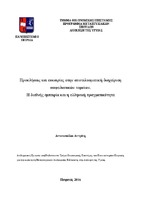Προκλήσεις και ευκαιρίες στην αποτελεσματική διαχείριση ασφαλιστικών ταμείων : η διεθνής εμπειρία και η ελληνική πραγματικότητα
Opportunities and challenges in successful insurance funds management : international experience and Greek factual basis

View/
Keywords
Διαχείριση ασφαλιστικών ταμείων ; Δημογραφική γήρανση ; Δημογραφική πυραμίδα ; Διανεμητικά - Κεφαλαιοποιητικά Συστήματα ; Συστήματα προκαθορισμένης παροχής – εισφοράς ; Τρεις Πυλώνες ; Ασφαλιστική μεταρρύθμιση ; Εθνικό Σύστημα Κοινωνικής Ασφάλισης ; Διαχείριση χαρτοφυλακίου ; Pension funds ; Περιουσία και απόδοση ασφαλιστικών ταμείων ; Capital Recovery ; ΑΕΕΑΠ ; Insurance funds management ; Population ageing ; Population pyramid ; Pay-As-You-Go and Funded pension plans ; Defined Benefit and Defined Contribution schemes ; Three Pillars Insurance Services ; Insurance reform ; National Social Security System ; Portfolio management ; Insurance fund assets and returns ; REITsAbstract
Insurance Funds accumulate capital invested in securities and other assets. Asset management should be efficient and value adding on behalf of beneficiaries. It is a mature market and precisely, in 2014, OECD countries pension funds’ assets under management are approximately USD 25 trillion.
Given this international experience, the scope of this dissertation is to point out both opportunities and challenges that can arise in insurance funds management. It is organized into two parts.
First part introduces factors that shape the pension fund investment framework, namely population ageing (chapter 1) and pension schemes structure (chapter 2). In the end of the first part, the three Pillars Insurance Services approach is introduced, summarizing the challenges that each of them faces in contemporary Greece. The main challenge of the first pillar is to tackle the demographic shifting and, at the same time, to maintain adequate, safe and sustainable Pensions schemes. For the second pillar is its further improvement (given that at this stage it does not seem to have a significant presence) through the formation of competent funds, that can equally emulate private pension funds. Finally, the main challenge of the third pillar is to address solvency issues of private insurance companies by strengthening supervision (Bank of Greece, Solvency II), in order to safeguard consumer savings so as to increase participation and thus to achieve higher replacement rates.
Second part analyses the theoretical base of portfolio management and investment performance evaluation (chapter 3). Moreover, understanding in international pension funds markets is approached through the presentation (historical evolution and current status) of pension fund market in OECD. Performance, portfolio structure and current trends are
analyzed. At the same time, the increase of alternative - non-traditional - forms of investment as a percentage of total investments is outlined. This is a tendency that appears mainly as a result of managers’ search for yield, due to the current economic conditions and low interest rates prevailing, in order to meet the financial requirements of the pension plans and, thus, may not be suitable for pension plans beneficiaries. Furthermore, academic literature is reviewed, spotlighting funds’ investment choices, management and performance.
At the end of the second part, Greek pension funds assets and their performances are assessed by underlining both past weaknesses and strong points. Also opportunities for further effective management are highlighted explicitly in the area of improving receivables collection and real-estate management.


